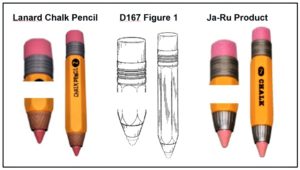Since Egyptian Goddess, Inc. v. Swisa, Inc., the sole test for determining whether a design patent has been infringed is the ordinary observer test. Under this test, “if, in the eye of an ordinary observer, giving such attention as a purchaser usually gives, two designs are substantially the same, if the resemblance is such as to deceive such an observer, inducing . . . purchase [of] one supposing it to be the other, the first one patented is infringed by the other.” In Lanard Toys, Ltd. v. Dolgencorp LLC, the Federal Circuit clarified that the ordinary observer test should consider element-by-element distinctions between the patented design and the prior art, and between the patented design and the accused product.
Lanard owns U.S. Patent No. D671,167 (“D167 patent”) and manufactured the Lanard Chalk Pencil, a pencil-shaped chalk holder, based on the patented design. Ja-Ru indisputably used the Lanard Chalk Pencil as inspiration for the design of its own product (the “Ja-Ru Product”), and competed directly against and took business from Lanard. The D167 patent, the Lanard Chalk Pencil, and the Ja-Ru Product are shown below.

Lanard filed suit in the district court, alleging infringement of its design patent. The district court entered summary judgment of noninfringement of the design patent. On appeal to the Federal Circuit, Lanard challenged the district court’s claim construction as well as its noninfringement holding as a matter of law. The Federal Circuit rejected both challenges.
The Federal Circuit first held that the district court properly construed the meaning and scope of the D167 patent. It observed that the district judge had faithfully followed Federal Circuit guidelines in construing the D167 patent claim to include non-functional elements as well as ornamental aspects of functional elements in the chalk holder design, namely “the columnar shape of the eraser, the specific grooved appearance of the ferrule [i.e. metal band], the smooth surface and straight taper of the conical piece, and the specific proportional size of these elements in relation to each other.”
The Federal Circuit also approved the district court’s consideration of prior art to the D167 patent in reaching its conclusion that “the overall appearance of Lanard’s design is distinct from this prior art only in the precise proportions of its various elements in relation to each other, the size and ornamentation of the ferrule, and the particular size and shape of the conical tapered end.” It held that the district court “construed the claim consistent with the drawings and pointed out the ornamental and functional features of the design as well as the various features as they relate to the prior art . . .”
The Federal Circuit also upheld the district court’s assessment of infringement. It agreed with the district court that an ordinary observer, taking into account the prior art, would not believe that the Ja-Ru Product is the same design shown in the D167 patent. It agreed with the district court that no reasonable factfinder could find the ordinary observer test met because the ordinary observer would be drawn to those aspects of the claimed design that differ from the prior art – e.g. the pattern on the ferrule, specific proportions, and straight taper of the conical piece – and could not conclude that Ja-Ru Product appropriated those aspects.
The Federal Circuit rejected Lanard’s argument that the district court erred by placing the patented design side-by-side with the Ja-Ru Product and conducting an element-by-element comparison of the D167 patent’s features and the Ja-Ru Product. The Court acknowledged that the proper application of the “ordinary observer” test requires a comparison of the overall designs, but it explained that the ordinary observer test still requires a court to consider how individual elements impact the overall design in light of the prior art. The Federal Circuit found that the district court properly held that “the design similarities stem from aspects of the [patented] design that are either functional or well-established in the prior art.”
The Federal Circuit also rejected Lanard’s other grounds for challenging the district court’s infringement analysis, notably its argument that the district court applied the discredited point of novelty test of infringement. The Federal Circuit reasoned that it was entirely proper for the district court to consider points of novelty in deciding the meaning and scope of the design patent in question. The court explained that it is important to consider the patented design and the allegedly infringing product in the context of the prior art and noted that the district court “placed those points of novelty in context by considering that those points of novelty would draw ‘the attention of the ordinary observer.’” The Federal Circuit determined that the district court “correctly balanced the need to consider the points of novelty while remaining focused on how an ordinary observer would view the overall design.”
Lanard teaches us that the ordinary observer test of infringement begins by understanding what ornamental features distinguish the patented design from the prior art. This includes identifying functional elements having ornamental aspects. In the claim construction step, a court determines the points of novelty that would draw the attention of the ordinary observer as a matter of law. Thereafter, the fact finder decides whether the ordinary observer test is met such that there is infringement. While the fact finder should compare the overall patented design to the accused design, it should consider whether the similarities relate to those aspects of the patented design that are functional or known in the prior art. Any such similarities should not weigh in favor of a finding of infringement.
Put more simply, Lanard teaches that the ordinary observer test is based on those ornamental features, and ornamental aspects of functional features, that were not present in the prior art, and considers how these features would impact the ordinary observer’s perception of the overall designs. If the differences between these points of novelty and the accused design are such that the overall design of the patented and accused product are not substantially the same, a finding of infringement is inappropriate.





 />i
/>i

